Tony Smith's Home Page
Ice Age Civilization
and
| Monuments | Culture
|
During the Ice Age of
340,000-330,000 years ago,
the Geminga supernova explosion irradiated Earth
and
the Neanderthals appeared.
The low sea levels due to glaciation created land bridges
for land migration of the Neanderthals.
The next two Ice Ages with low sea levels creating land bridges were
about 270,000-230,000 years ago
and
about 160,000-130,000 years ago, which was the beginning
of the African/Oceanic Ice Age Civilization Ice Age Civilization, as
Modern Humans displaced the Neanderthals in Africa and Oceanic areas.
In Nature 405 (4 MAY 2000)
65-69, Walter et al report
"... the 'out of Africa' hypothesis contends that modern
humans evolved in Africa between 200 and 100 kyr ago, migrating to
Eurasia at some later time ... the discovery of early Middle Stone
Age artefacts in an emerged reef terrace on the Red
Sea coast of Eritrea, which we date to the last interglacial
(about 125 kyr ago) ... this is the earliest well-dated evidence
for human adaptation to a coastal marine environment,
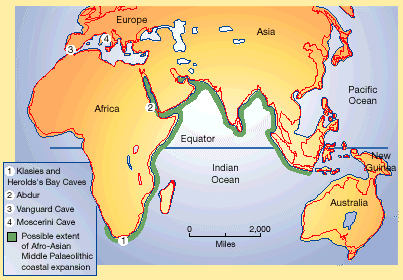
heralding an expansion in the range and complexity of human
behaviour from one end of Africa to the other. This new,
widespread adaptive strategy may, in part, signal the onset of
modern human behaviour, which supports an African origin for
modern humans by 125 kyr ago. ...". (Image is from News and Views
article in Nature 405 (4 MAY
2000) 24-27.)
An article by Chris Stringer in Nature
423 (12 June 2003) 692-693 says
"... The idea that modern humans originated in Africa,
with populations subsequently spreading outwards from there, has
continued to gain support lately. But much of that support has
come from analyses of genetic variation in people today1, and from
fossil and archaeological discoveries dated to within the past
120,000 years2,3 &emdash; after our species evolved. Hard evidence
for the inferred African origin of modern humans has remained
somewhat elusive, with relevant material being fragmentary,
morphologically ambiguous or uncertainly dated. ...
... the most securely dated and complete early fossils that
unequivocally share an anatomical pattern with today's H. sapiens
are actually from Israel, rather than Africa. These are the
partial skeletons from Skhul and Qafzeh, dating from around
115,000 years ago. Their presence in the Levant is usually
explained by a range expansion from ancestral African populations,
such as those sampled at Omo Kibish [ Ethiopia ] or Jebel
Irhoud [ Morocco ] ... around 125,000 years ago. ..
... So the fossilized partial skulls from ...[ Herto
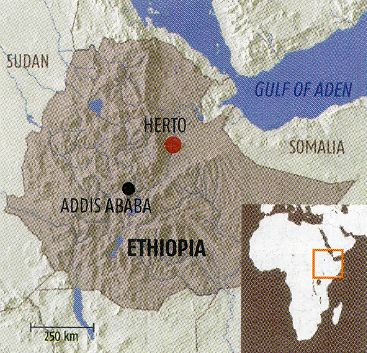
image from New Scientist (14 June 2003, page 5)
]...
Ethiopia that are described ... by White and colleagues ... on
pages 742 and 747 of this issue are probably some of the most
significant discoveries of early Homo sapiens so far, owing to
their completeness and well-established antiquity of about 160,000
years. ... The fossils are complete enough to show a suite of
modern human characters, and are well constrained by argon-isotope
dating to about 160,000 years ago. ...
... Because of Africa's great area and still limited fossil
record, it is uncertain whether the pattern of H. sapiens
evolution there was essentially continent-wide, or was a
more localized - and perhaps punctuational - process.
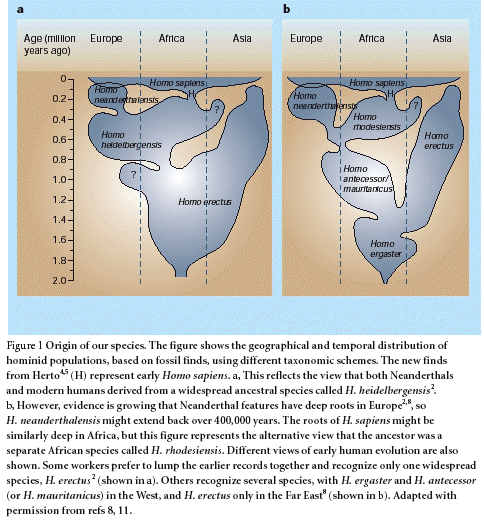
The Herto finds shift the focus once again to East Africa. It
seems from these crania and from possibly contemporaneous fossils,
such as those at Ngaloba [Tanzania], Singa [Sudan]
and Eliye Springs [Kenya], that human populations of this
era showed a great deal of anatomical variation. So, did the early
modern morphology spread outwards from East
Africa ... ? ...".
About 115,000 years ago the Early Wisconsin Glaciation began in
North America, and about 70,000 years ago the Early Wurm Glaciation
began in Europe.
About 35,000 years ago, the Geminga shock wave hit Earth,
the Late Wisconsin Glaciation of Earth began,
and the Cro-Magnons displaced the Neanderthals in Europe,
beginning the European Ice Age Civilization.
Nicholas Wade, in a 7 December 1999 article in The
New York Times, says: "Two genetic surveys of human
populations bring new evidence to bear on a pivotal event in
prehistory, the first dispersal of modern humans from Africa. One
study, based on analysis of people in East Africa and India,
suggests that the first emigration of modern humans was eastward,
toward Asia, and not northward through the eastern Mediterranean.
A second, drawing on DNA data from 50 ethnic groups around the
world, concludes that the ancestral population from which the
first emigrants came may have numbered as few as 2,000 people.
Both studies suggest that the most recent common ancestor of the
emigrants lived 60,000 to 40,000 years ago.
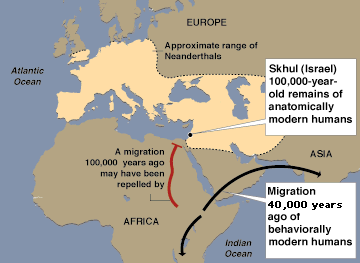
... Dr. Richard G. Klein of Stanford University and others
believe that some major genetically based neurological change,
like the development of language, occurred about 50,000 years
ago. This transformation, he infers, was the spur that led
behaviorally modern humans to innovate their characteristic suite
of more advanced stone implements, develop the first forms of art
and spread throughout the world. ... Dr. Klein's data suggest that
the humans of 100,000 years ago, anatomically modern but not like
modern people in their behavior, did not spread out of Africa at
that time.
[However, According to a
Discover article:
"... people all over the world are amazingly similar. Some
anthropologists believe that this genetic homogeneity is the
result of a "population bottleneck"--that at some time in the
past our ancestors went through an event that greatly reduced
our numbers and thus our genetic variation. Based on estimates
of mutation rates, Penn State geneticist Henry Harpending says
the bottleneck happened sometime after ... 100,000 years ago
and before a population increase ... around 50,000 years ago.
Now archeologist Stan Ambrose of the University of Illinois has
linked Harpending's theory with geologic evidence to explain
what caused the bottleneck--a giant volcanic eruption. ...
Mount Toba in Sumatra blew 800
cubic kilometers of ash into the air--4,000 times as much as
Mount St. Helens--the largest volcanic eruption in more than
400 million years. Toba buried most of India under ash and must
have darkened skies over a third of the hemisphere for weeks.
... a six-year global volcanic winter ensued, caused by
light-reflecting sulfur particles lingering in the atmosphere.
Average summer temperatures dropped by 21 degrees at high
latitudes, and 75 percent of the Northern Hemisphere's plants
may have died. ... A thousand-year ice age began ... caused
perhaps by an increasing amount of snow that failed to melt
over the summer. This snow cover would have reflected more
sunlight off Earth's surface, making the world still colder.
The effect on humans, who had been enjoying a relatively warm
period, must have been devastating. ... Perhaps only a few
thousand people ... survived. ...".]
A new genetic study, by Dr. A. Silvana Santachiara-Benerecetti
of the University of Pavia in Italy and colleagues, confirms the
view that the first dispersal of modern humans was not until about
50,000 years ago, and that the direction was eastward toward Asia.
The study, published in Nature Genetics last week, is based on
mitochondrial DNA, the genetic material of the small
energy-producing organelles inside every cell. Because
mitochondria are inherited with the egg, from the mother alone,
their DNA escapes the shuffling that occurs in sexual
reproduction, and any changes reflect the occasional random
mutation in the DNA.
[However, the 50,000 year time may be too long,
and the true time may be about 36,525 years, which rounds off
to 40,000 years, because it has been shown by Awadalla,
Eyre-Walker, and Smith, in Science
286 (24 December 1999) 2524-2525, that "... The assumption that
human mitochondrial DNA is inherited from one parent only and
therefore does not recombine is questionable. Linkage
disequilibrium in human and chimpanzee mitochondrial DNA
declines as a function of the distance between sites. This
pattern can be attributed to one mechanism only: recombination.
... Many inferences about the pattern and tempo of human
evolution and mtDNA evolution have been based on the assumption
of clonal inheritance. These inferences will now have to be
reconsidered. ...". Therefore I put a 40,000 year date in the
map from the New York Times article.]
On the basis of these mutations, biologists can construct a
family tree of mitochondrial lineages and, by estimating the
mutation rate, figure out the time that has elapsed since the
mutation at the root of the tree. Dr. Santachiara-Benerecetti and
her colleagues studied a particular pattern of mitochondrial DNA
that is well known in India. They found an earlier form of the
pattern among people in Ethiopia, suggesting that East Africa was
its place of origin. Signs of the pattern also exist among many
people in Saudi Arabia, but not among inhabitants of the eastern
Mediterranean. This provides the first genetic evidence, the
Italian biologists say, that the human migration route out of
Africa was from eastern Africa along the coast toward Southeast
Asia and Australia.
Another new genetic study, by Dr. Marcus Feldman of Stanford
University and others, makes an interesting counterpart to the
Italian study because it is based on a different kind of DNA but
reaches similar conclusions. Dr. Feldman and his colleagues looked
at segments of the Y chromosome, another part of the human genome
that escapes the usual shuffling of the reproductive process.
Studying Y chromosomes from around the world, they concluded that
the most recent common ancestor of all these Y's was carried by a
man who lived only 40,000 years or so ago. Even though all
Y chromosomes can be traced back to a single individual, this does
not mean a single Adam was the species' only male representative.
The founding population from which the world's present population
is derived consisted of about 2,000 individuals, according to the
new data, Dr. Feldman said. One Y chromosome in such a population
will eventually dominate in the descendants after all the other Y
lineages are brought to a halt, whether because their owners have
no children or beget only daughters. The 40,000-year date, which
has a large range of uncertainty, is much more recent than others,
in part because the earlier estimates were forced to assume, quite
unrealistically, that the size of the human population remained
constant throughout prehistory. Dr. Feldman assumed an
exponentially expanding population, which yields a more recent
date of origin. His study is published in the current issue of the
journal Molecular Biology and Evolution. ...".
The two new studies represent a convergence of the genetic and
archaeological data bearing on modern human origins, said Dr. Luca
Cavalli-Sforza, a leading population geneticist at Stanford
University, who was not an author of either study. ... These
behaviorally modern humans "had three big improvements in culture
-- language, boats or rafts, and Aurignacian technology," Dr.
Cavalli-Sforza said, referring to the more sophisticated stone
implements. ...".
The last Glacial Maximum hit its peak about 21,000 to 18,000 years ago.
11,600 years ago there was the Younger Dryas cold snap,
with temperatures 14 degrees C below present-day,
after which the Vela X supernova was seen on Earth
and the Taurid/Encke comet fragmented, and
a very sudden (50 years or so) warming event
ended the Ice Age and marked the start of the HOLOCENE AGE
of warm climate and glacial retreat.
If 11,600 years ago marked the beginning of the Rule of Mortal
Humans on Earth according to Manetho (Egyptian historian ca. 343 BC),
then
his immediately preceding period of 11,025 years of Rule by
Demigods and Spirits of the Dead (followers of Horus)
would have begun about 22,625 years ago, or about the time of the
beginning of the last Glacial Maximum, and
his first period, preceding that, of 13,900 years of Rule of Gods
on Earth would have begun about 36,525 years ago, or about the time
of the Geminga shock wave, the Late Wisconsin Glaciation, and the
appearance of Cro-Magnons.
The total period of the Mantho's Ice Age Civilization prior to the
Rule of Mortal Humans is therefore about 36,525 - 11,600 = 24,925
years, which is approximately the Earth
precession period of 26,000 years and the travel
time of a light beam from the center of our Galaxy to our Sun,
about 25,000 light years distance. It may have been the time of
construction of the Giza Complex of the Sphinx
and the Pyramids, including the Great Golden
Pyramid. The Ice Age Civilization may have been more spiritual
and less crudely technological than the present Rule of Mortal
Humans.
This unconventional interpretation of Manetho's chronology is not
inconsistent with his list of 30 Egyptian dynasties from about 2920
BC to about 343 BC, but it does extend his chronology from being a
history of the past to a History of the Past and Future, in which we
are now living near the end of the Rule of Mortal Humans.
Manetho's Rule of Gods, Demigods, and Spirits of the Dead,
on Earth before 11,600 years ago,
might then be called the Ice Age Civilization.
Before the Ice Age that began about 35,000 years ago,
there had been about 95,000 years
(95,000 years is approximately one long Milankovitch cycle
of variation of eccentricity of the Earth's orbit)
of mild climate since the end of the preceding Ice Age
about 130,000 years ago.
During 130,000-35,000 years ago the Neanderthals were replaced
by modern (Cro-Magnon) humans, whose artifacts (especially art)
can be found in places (such as caves) all over the world.
The wide distribution of high-level cave paintings suggests
that human culture world-wide had cultivated
intellectual/spiritual dimensions to a high level,
although material technology may not have been so highly developed.
During 130,000-35,000 years ago the Earth was not continuously warm,
as there were cold intervals such as one about 75,000 years ago
possibly due to a large volcanic eruption at Toba, Sumatra,
and generally the climate got cooler as time progressed.
As the climate deteriorated, most of the humans migrated
from the newly cold areas to the remaining warmer areas.
It is possible that some of the more highly cultivated people
did not relocate to the warmer areas,
but stayed on in spiritual communities
in such areas as
the Abyssinian Highlands in Africa,
near the Nile River Valley and the East African Rift Valley,
and
the Altai Mountains in the center of Eurasia,
near Lake Baikal, Siberian Rivers, Lake Balkash,
the ancient lakes of the Takla Makan and the Gobi,
the ancient rivers of India, and the rivers of China.
During the Ice Age from about 35,000 years ago
until about 11,600 years ago,
sea levels were lower due to the water in the glaciers.
At the peak of glaciation, about 18,000 years ago,
sea level was about 85 meters lower than it is now
(which is about 50 meters lower than it was when
the Ice Age ended about 11,600 years ago).
At 18,000 years ago, the Earth looked like this
map from Earth and Life Through Time,
by Steven Stanley, (Freeman (2nd ed) 1989):
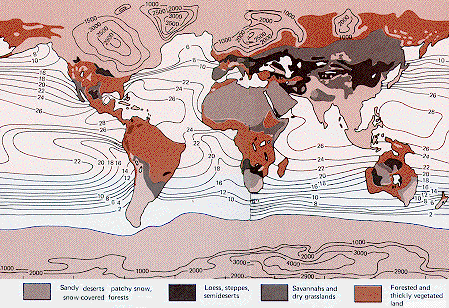
Glaciers of about 20,000 years ago
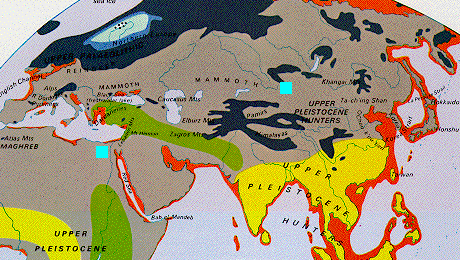
are shown in dark blue, blue, and light blue
in this map from The Times Atlas of World History
(Times Books (4th ed) 1993).
Red shows the extended land area due to low sea
levels about 20,000 years ago, and
green and yellow show areas favorable for human habitation
in wet and dry periods, respectively.
The two turqouise squares show the locations
ofthe Sphinx-Giza complex at the mouth of the Nile River,
at the intersection of the favorable Asian and African areas,
and
Gora Belukha in Central Asia,
which may be known in China as Kunlun Shan,
home of Xi Wang Mu, the Queen of the West,
and in India as Su Meru, home of Indra.
In Eurasia, during the dry period of the Ice Age,
most people probably migrated to the large land mass
of Japan-Korea-China-Southeast Asia-Indonesia-South India,
with some highly cultivated spiritual people
staying in the glacier-covered Altai Mountains.
Gora Belukha, 14,783 feet, the highest Altai Mountain,
is in Siberia near Mongolia, China, and Kazakhstan.
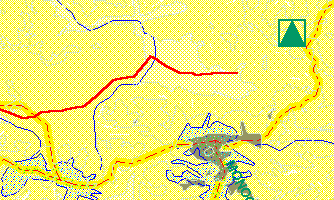
It is near the beginning point of the 9 March 1997 solar eclipse.
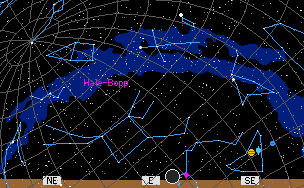
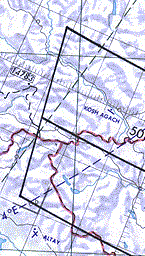
The Altai region is known as a cross-roads
between China, India, the Mediterranean, and Europe.
It could have been a common source for
spiritual systems and languages.
An Altai common source could account for
similarities among such spiritual systems as
Chinese Taoism, Indian Vedism, Tibetan Bon, and European Druids,
as well as
the similarities among
the Ainu language of Japan, Sarasvati-Sindhu language of India,
and Basque language and Ogam script of Europe
that indicate the existence of a Global Early Language.
As the Ice Age ended, the glaciers thawed,
flooding such areas as the Takla Makan
and the East Asia Lowlands,
so many people were forced to migrate to
India, IndoChina, or China.
Flooding of the Persian Gulf and the margins of
the Black and Mediterranean Seas would have been
less extensive than the flooding of the East Asia Lowlands,
but would have also forced some people to migrate
to Persia, Turkey, and Greece.
In Africa, during the Ice Age
most people probably lived South of the Mediterranean,
in the favorable Central African region
that included the Abyssinian Highlands.
The Ge'ez language of Abyssinia seems to be closely related
to a Global Early Language.
As the Ice Age ended, the Northern Nile River Valley
became wet and productive, so people migrated there.
The African situation would have been more
Northward expansion into newly productive land,
whereas
the Asian situation would have involved more
resettlement to the Interior of people displaced by floods.
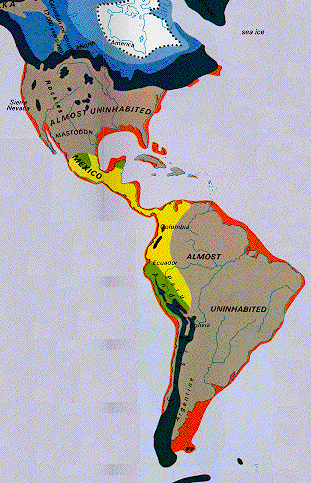
In the Americas, during the dry period of the Ice Age,
most people probably migrated to the Olmec region
of Central America and the Northern Andes.
The Olmec language seems to be closely related
to a Global Early Language.
As the Ice Age ended, Central Mexico, the Yucatan,
and the Southern Andes became more habitable,
so people probably moved there.
An interesting question is the extent of contact
during the Ice Age among three major spiritual centers:
1 - The Altai Mountains, which probably did not ever have
a large population due to climate and terrain.
2 - The Americas, which due to smaller favorable area
probably did not have large population.
3 - The Abyssinian Highlands,
which was probably the only one of the three
to have a large population and favorable climate.
Possible evidence of Ice Age Civilization
in the period of 35,000 to 12,000 years ago include
large stone structures under the sea near Japan,
known as the Japanese Pyramids and called Hiramitsuto,
as to which Shun Daichi says
"There are six places they found structures in the Okinawa area.
One is located in Taiwan. All of them are under the sea.
All the geologists agree that the underwater structures are
at least 12,000 years old."
and
a possible dressed masonry structure site,
now under the sea, off the Bimini coast near Florida,
in the Gulf of Mexico - Caribbean Sea region.
However, it is possible that both of those sites
are natural geological phenomena,
perhaps similar to basalt prisms or naturally fractured coral.
Clear evidence of Ice Age Civilization
in the period of 35,000 to 12,000 years ago
is found in Fukui Cave of Northern Kyushu Island,
the southwesternmost island of Japan,
in the form of Jomon pottery containers, which
(according to Joseph B. Lambert's book
Traces of the Past (Addison-Wesley 1997))
have been dated as slightly later than
12,750 +/- 500 years old,
and therefore consistent with coinciding with
the end of the Ice Age about 11,600 years ago,
so that the Jomon pottery could have been taken
to Fukui Cave of Kyushu by Jomon people
of the Ice Age Civilization when they fled
the flooding of the surrounding lowlands
after the Ice Age ended around 11,600 years ago.
The Jomon people, according to Jared
Diamond's article Japanese Roots (Discover Magazine June 1998, pp.
86-94), survive as the Ainu of Hokkaido and northern Honshu, the
northeasternmost Japanese islands. They were displaced by Yayoi
invaders from Korea around 400 BC.
Jomon pottery containers are the oldest known, and the only ones
known to exist before the end of the Ice Age about 11,600 years ago.
In the rest of Europe, Asia, and Africa, the oldest are Turkish,
about 10,500 years old. In the Americas, the oldest from Ecuador,
Colombia, Mexico, and the Southeastern United States, and are only
about 4,500 years old, according to Joseph B. Lambert's book Traces
of the Past (Addison-Wesley 1997).
Water-tight Jomon containers made it possible for people to boil
and steam food. As Jared Diamond notes in his article Japanese Roots
(Discover Magazine June 1998, pp. 86-94), the Jomon Ice Age
Civilization could expand their diet to include boiled or steamed
leafy vegetables and shellfish. Boiling could detoxify such toxic
foods as acorns, and soft-boiled foods could be eaten by infants and
toothless old people. They could live well in and near their own
villages by hunting and gathering, with no need for agriculture or
warfare. They got along quite well without metal tools, writing,
weaving, and social/political class structure.
The Ice Age Civilization could have occupied
the large land mass of the Sunda Shelf

(Times Atlas of Archaelogy, Crescent 1995)
of Japan-Korea-China-Southeast Asia-Indonesia-South India,
much of which is now under water.
Although the pottery was too bulky for everyday travel, it
could have been carried to Fukui Cave in the high ground of Northern
Kyushu Island, now the southwesternmost island of Japan, by Jomon
people when they fled the flooding of the surrounding lowlands after
the Ice Age ended around 11,600 years ago.
Since the water that covers much of the area
of the Ice Age Civilization is not clear water like Bimini,
but is in seas heavily silted by rivers like the
Yellow and Yangtze in the northern Sunda Shelf between China and Korea,
and the Mekong in the southern Sunda Shelf,
and
since a lot of the remaining area has a lot of tropical jungle,
not to mention being subject to active volcanism
and earthquake activity,
and
since the American and Congo regions are now tropical jungles,
artifacts in the 35,000 to 12,000 year age range,
such as Jomon pottery in the northern Sunda Shelf,
may now be very hard to find.
The Jomon pottery of 11,600 years ago is evidence of an Ice Age
Civilization.
The art of the Ice Age period indicates that the Ice Age
Civilization may have been more advanced, especially in social
structure and relations with
higher intellectual/spiritual
levels, than any later civilization including our present
one.
For instance, our present civilization is just now beginning to
understand the levels of reality related
to Many-Worlds quantum theory; to
discover how quantum computers
work; and to utilize other promising New
Technologies.
As it is possible that the Ice Age Civilization was more advanced
socially and intellectually/spiritually than ours, it is also
possible that the Ice Age Civilization could have been the builders
of the Sphinx-Giza complex, particularly
in light of the facts that:
the only area that clearly had favorable climates in both the Ice
Age of 35,000 to 12,000 years ago (see map
above on this page) and in the period of 11,000
or 12,000 to 6,000 years ago (see map on that page) is the
homeland of the African Abyssinian Highlanders;
the Asian part of the Ice Age Civilization, evidenced by Jomon
pottery, was so disrupted by flooding at the end of the Ice Age about
11,600 years ago, that only the Jomon people of the Japanese Islands
(whose remnants today are the Ainu) could continue their Ice Age
Civilization without severe conflict with others fighting over
limited resources (on the Asian mainland, the repository of Ice Age
Civilization was probably individual Taoists living in remote forests
and mountains); and
the Sphinx-Giza complex is located at
the intersection of the Asian and African areas of the Ice Age
Civilization.
In my opinion, about 11,000 to 6,000 years
ago was the latest reasonable time for construction of the
Giza Sphinx and Pyramids. After about
6,000 years ago, the level of technology of the Great
Pyramid at Giza could not be maintained by the economic and
social structure of the indigenous population.
From about 11,000 to 6,000 years ago the
Abyssinian Highlanders of the African Nile
Lake were the most highly organized remnant of the Ice Age
Civilization. They were the probable source of ways to cope with the
changed circumstances of the post-Ice Age world, including
agriculture, mining,written communication, and organized armies, thus
forming a Global Early Civilization with a
Global Early Language.
Diodorus of Sicily, author of Bibliotheca Historica, lived in the
time of Julius Caesar and Augustus (Encyclopaedia Britannica).
Richard Poe, in Black Spark, White Fire (Prima 1997), quotes Diodorus
as saying:
"Now the Ethiopians ... were the first of all men. ...
... the Egyptians are colonists sent out by the Ethiopians,
Osiris having been the leader of the colony ...
... Osiris ... gathered together a great army,
with the intention of visiting all the inhabited earth
and teaching the race of men how to cultivate ...
... for he supposed that if he made men give up their
savagery and adopt a gentle manner of life
he would receive immortal honors. ..."
Diodorus said that Osiris then went from Egypt and Ethiopia
to Arabia, Greece, and India.
Poe also cites linguists who think that AfroAsiatic Languages
originated in the Abyssinian Highlands, and radiated out therefrom
about 12,000 to 10,000 years ago, which is consistent with the
Abyssinian Highlanders being the repository of a Global
Early Language which they reintroduced to the post-Ice Age
world.
Monuments:
The Giza Sphinx and Pyramids may
have been built by the Ice Age Civilization.
When the Ice Age ended about 11,600 years ago, the Jomon
people may have moved from the flooded Sunda Shelf lowlands to high
ground, such as Fukui Cave of Kyushu, Japan, where Jomon pottery
of that age has been found. On what then became the Islands of Japan,
the Jomon established a culture that lasted for 10,000 years, and
may have been a continuation of the Ice Age Civilization.
According to Jared
Diamond's article Japanese Roots (Discover Magazine June 1998, pp.
86-94), the present-day remnants of the Jomon are the Ainu of
Japan. Characteristics of the Jomon Ice Age Civilization include:
- Equalitarian, classless society with no central government or
bureaucracy.
- Population (up to about 250,000 for all the Japanese Islands)
balanced with food supply naturally obtainable by Hunting and
Gathering .
- Pottery for cooking leafy vegetables, seafood, and
acorns.
- Heavy stone tools.
- Substantial houses, in villlages of 50 or more houses plus
cemeteries.
What the Jomon Ice Age Civilization did NOT have is equally
revealing:
- No organized agriculture that might provide for a larger
population at the expense of imbalances in Earth's
Natural Order.
- No weaving to provide more clothing than a natural supply of
animal skins could produce.
- No metal tools for either
- organized agriculture (to produce more food) or
- organized warfare (to take food and resources from
others).
- No writing, and therefore no complex laws and regulations.
- The Giza Pyramids also contain
no writing.
- Writing is not needed for direct communication of ideas
without the necessity for translating them into symbols (of
language, math, etc.). Such translations can distort
ideas.
- Dolphins, who have been on Earth
for 20 million years, might also communicate directly.
What about other remnants of Ice Age Civilization?
From the end of the Ice Age about 11,600 years ago until about
6,000 years ago, the Nile River Valley was a good place to live where
the people of the Ice Age Civilization could continue their high
culture without much disruption, in marked contrast to the situation
in China where the end of the Ice Age
brought great turbulence
At the end of the Ice Age about 11,600 years ago, many people of
the Ice Age Civilization were displaced from the flooded
Sunda Shelf and came into China, where they began to compete for
food and resources. A few of those people refused to abandon their
high culture that was balanced with nature. They isolated themselves
from the fierce competition for resources by living in the forests
and mountains, and became the Taoists that
we know today. Throughout the years, according to Jared Diamond
(Guns, Germs, and Steel, W. W. Norton 1997), the Taoists revealed to
the general population such techniques as canal lock gates, cast
iron, deep drilling, animal harnesses, gunpowder, kites, magnetic
compasses, movable type, paper, porcelain, printing, sternpost
rudders, wheelbarrows, and more. In China, unlike the Nile
River Valley, the transition at the end of the Ice Age was
turbulent.
The end of the Ice Age may have also been turbulent in many other
areas of the world, such as Vedic
Indus-Ganges, Sumer, and Mesoamerica, where the main heritage of
the Ice Age Civilization may be legends of Gods and Early Men.
This page on human civilizations from about 35,000 to about 12,000
years ago is based in part on the WWW materials of Mark
Hammons. Although his views about the history of the past 35,000
years or so are different from mine in many details, we agree that
the Great Golden Pyramid looks like a device,
not just a tomb.
Tony Smith's Home Page
......










